Unit 6 Shopping PB Let’s talk 教案
文档属性
| 名称 | Unit 6 Shopping PB Let’s talk 教案 | 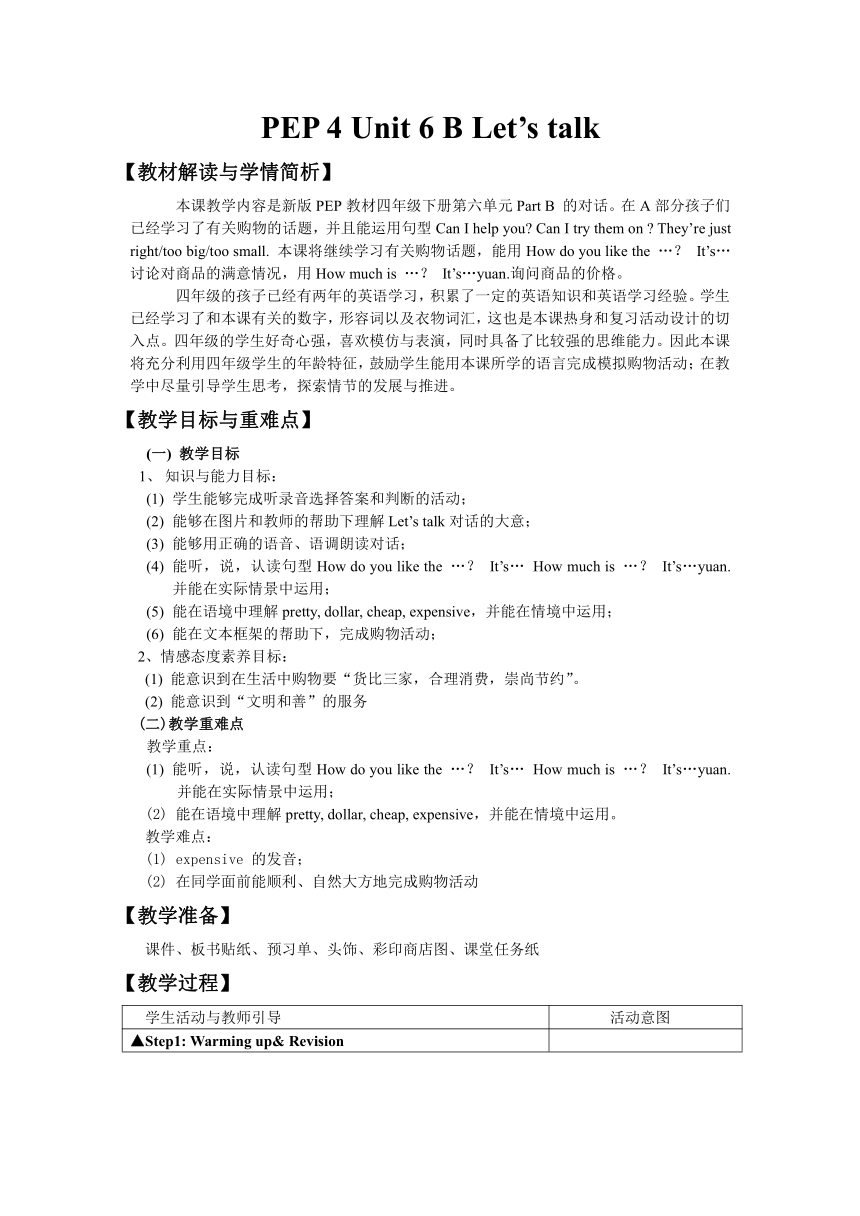 | |
| 格式 | zip | ||
| 文件大小 | 12.0MB | ||
| 资源类型 | 教案 | ||
| 版本资源 | 人教版(PEP) | ||
| 科目 | 英语 | ||
| 更新时间 | 2019-03-28 14:09:25 | ||
图片预览

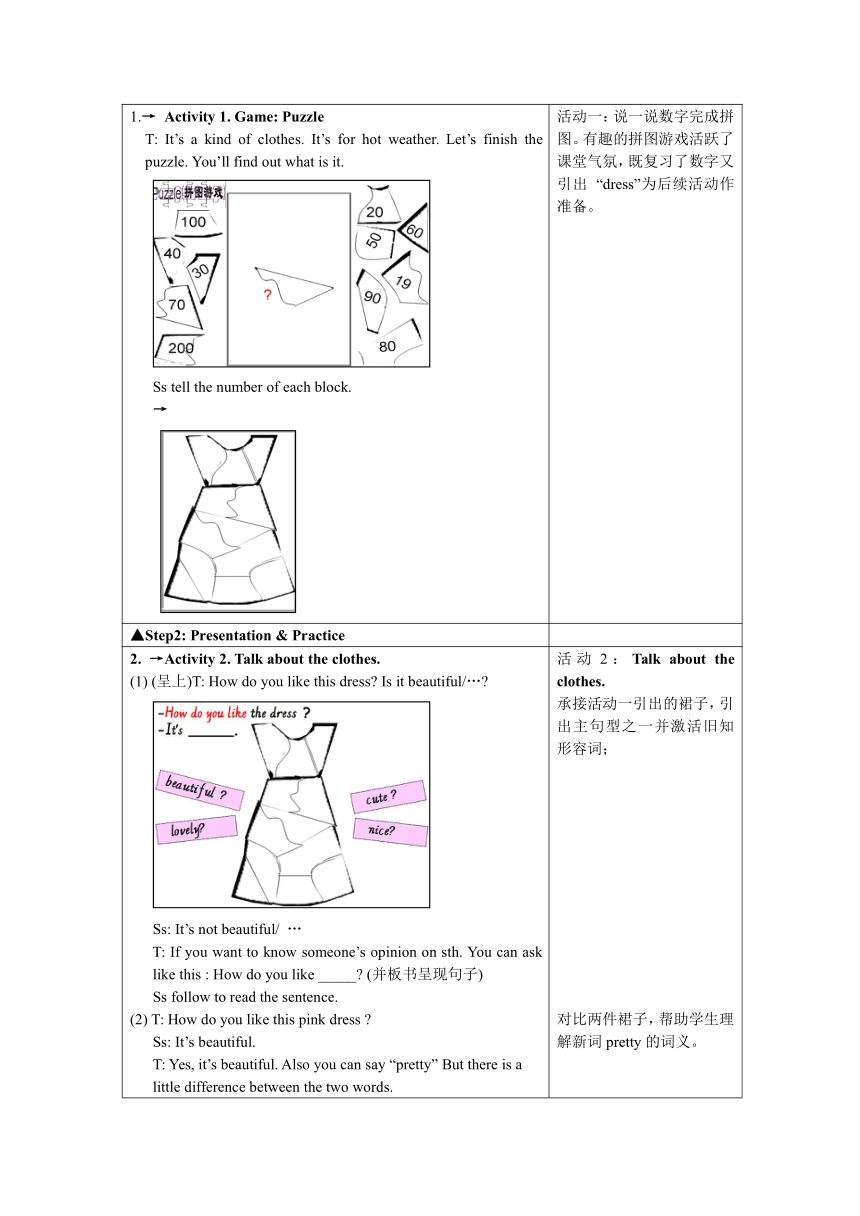
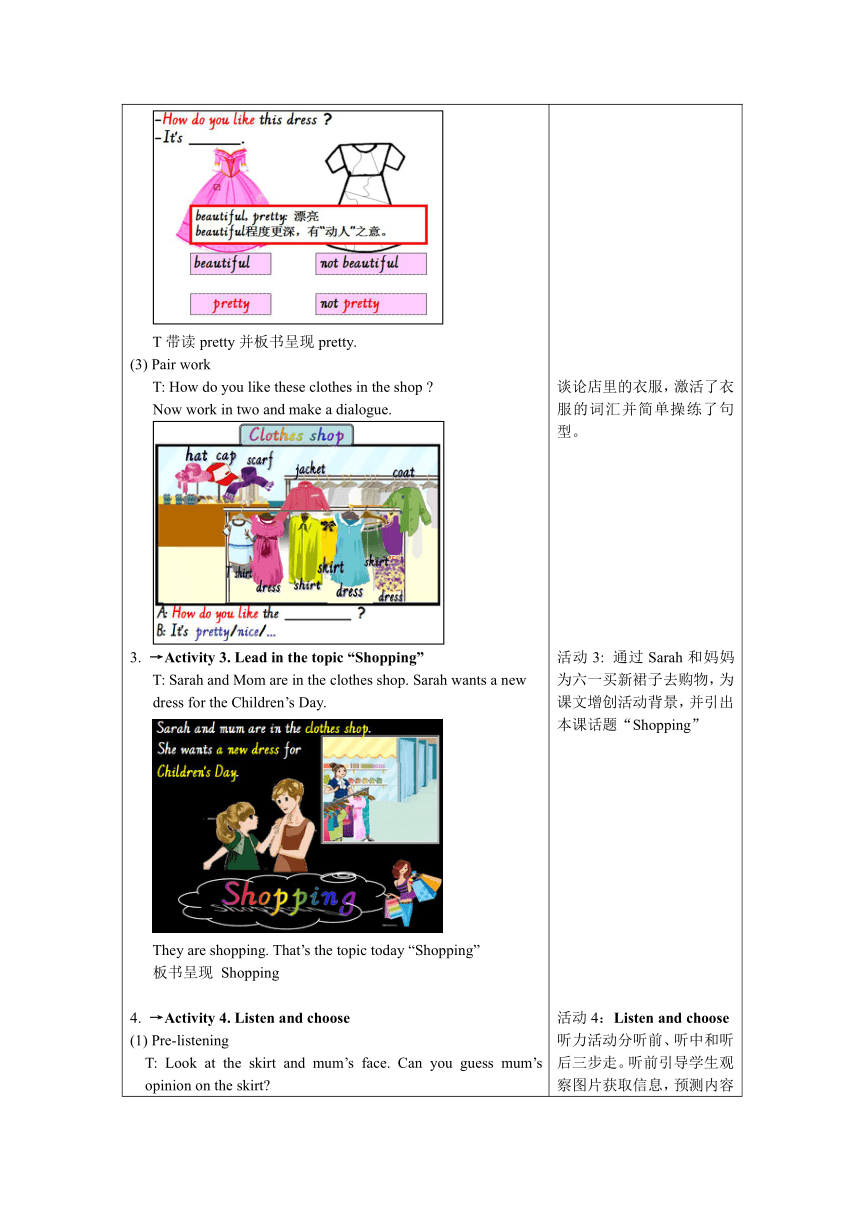
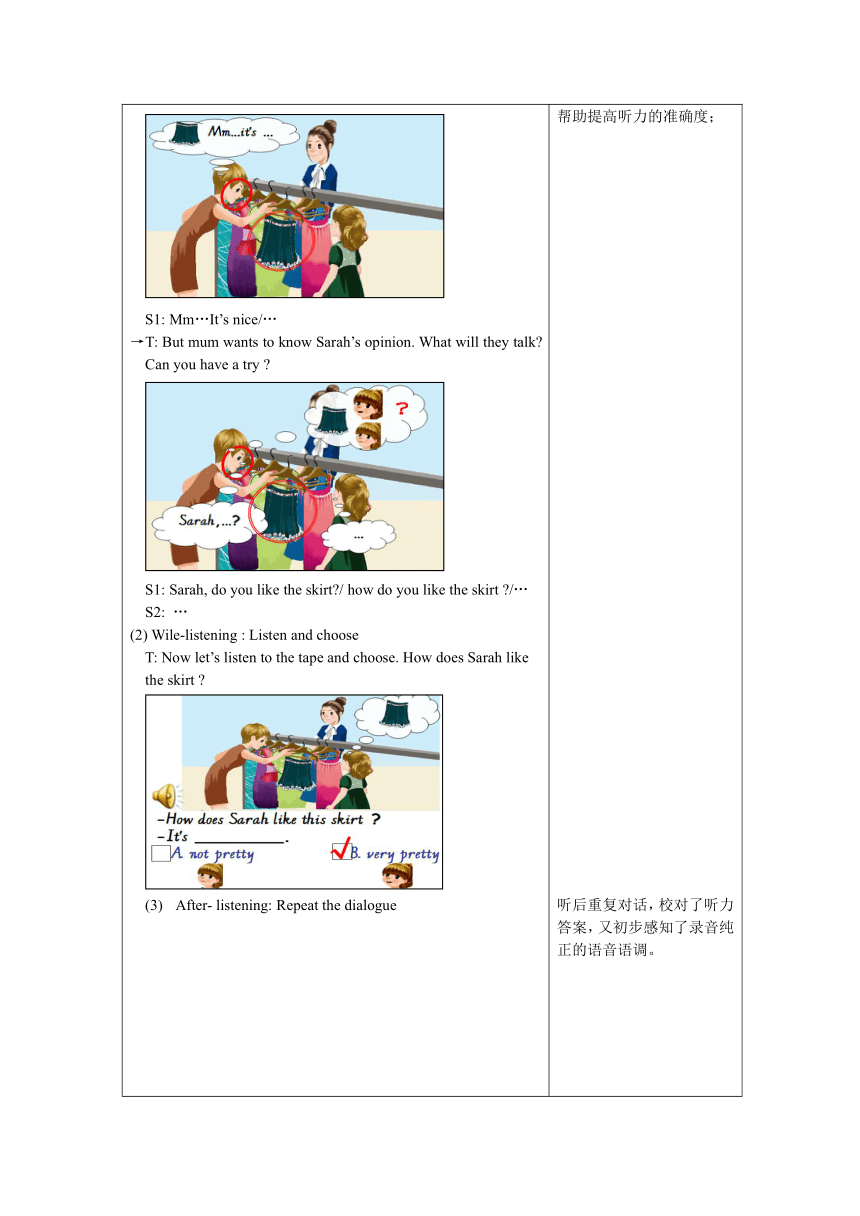
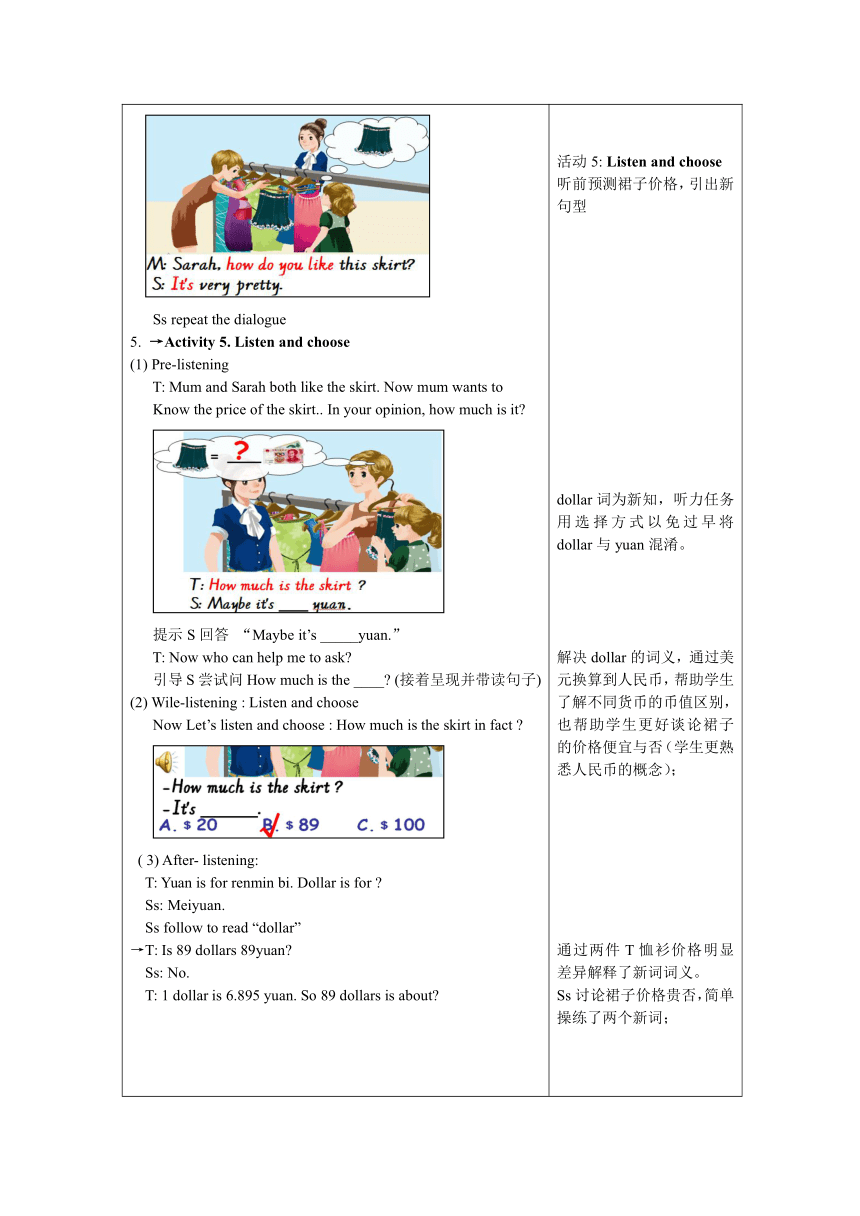
文档简介
PEP 4 Unit 6 B Let’s talk
【教材解读与学情简析】
本课教学内容是新版PEP教材四年级下册第六单元Part B 的对话。在A部分孩子们已经学习了有关购物的话题,并且能运用句型Can I help you? Can I try them on ? They’re just right/too big/too small. 本课将继续学习有关购物话题,能用How do you like the …? It’s…讨论对商品的满意情况,用How much is …? It’s…yuan.询问商品的价格。
四年级的孩子已经有两年的英语学习,积累了一定的英语知识和英语学习经验。学生已经学习了和本课有关的数字,形容词以及衣物词汇,这也是本课热身和复习活动设计的切入点。四年级的学生好奇心强,喜欢模仿与表演,同时具备了比较强的思维能力。因此本课将充分利用四年级学生的年龄特征,鼓励学生能用本课所学的语言完成模拟购物活动;在教学中尽量引导学生思考,探索情节的发展与推进。
【教学目标与重难点】
(一) 教学目标
1、 知识与能力目标:
(1) 学生能够完成听录音选择答案和判断的活动;
(2) 能够在图片和教师的帮助下理解Let’s talk对话的大意;
(3) 能够用正确的语音、语调朗读对话;
(4) 能听,说,认读句型How do you like the …? It’s… How much is …? It’s…yuan.并能在实际情景中运用;
(5) 能在语境中理解pretty, dollar, cheap, expensive,并能在情境中运用;
(6) 能在文本框架的帮助下,完成购物活动;
2、情感态度素养目标:
(1) 能意识到在生活中购物要“货比三家,合理消费,崇尚节约”。
(2) 能意识到“文明和善”的服务
(二)教学重难点
教学重点:
(1) 能听,说,认读句型How do you like the …? It’s… How much is …? It’s…yuan.并能在实际情景中运用;
(2) 能在语境中理解pretty, dollar, cheap, expensive,并能在情境中运用。
教学难点:
(1) expensive 的发音;
(2) 在同学面前能顺利、自然大方地完成购物活动
【教学准备】
课件、板书贴纸、预习单、头饰、彩印商店图、课堂任务纸
【教学过程】
学生活动与教师引导 活动意图
▲Step1: Warming up& Revision
1.→ Activity 1. Game: Puzzle T: It’s a kind of clothes. It’s for hot weather. Let’s finish the puzzle. You’ll find out what is it. Ss tell the number of each block. → 活动一:说一说数字完成拼图。有趣的拼图游戏活跃了课堂气氛,既复习了数字又引出 “dress”为后续活动作准备。
▲Step2: Presentation & Practice
2. →Activity 2. Talk about the clothes. (1) (呈上)T: How do you like this dress? Is it beautiful/…? Ss: It’s not beautiful/ … T: If you want to know someone’s opinion on sth. You can ask like this : How do you like _____? (并板书呈现句子) Ss follow to read the sentence.(2) T: How do you like this pink dress ? Ss: It’s beautiful. T: Yes, it’s beautiful. Also you can say “pretty” But there is a little difference between the two words. 活动2:Talk about the clothes.承接活动一引出的裙子,引出主句型之一并激活旧知形容词; 对比两件裙子,帮助学生理解新词pretty的词义。
T带读pretty并板书呈现pretty.(3) Pair work T: How do you like these clothes in the shop ? Now work in two and make a dialogue. 3. →Activity 3. Lead in the topic “Shopping” T: Sarah and Mom are in the clothes shop. Sarah wants a new dress for the Children’s Day. They are shopping. That’s the topic today “Shopping” 板书呈现 Shopping 4. →Activity 4. Listen and choose (1) Pre-listening T: Look at the skirt and mum’s face. Can you guess mum’s opinion on the skirt? S1: Mm…It’s nice/… →T: But mum wants to know Sarah’s opinion. What will they talk? Can you have a try ? S1: Sarah, do you like the skirt?/ how do you like the skirt ?/… S2: …(2) Wile-listening : Listen and choose T: Now let’s listen to the tape and choose. How does Sarah like the skirt ? After- listening: Repeat the dialogueSs repeat the dialogue5. →Activity 5. Listen and choose (1) Pre-listening T: Mum and Sarah both like the skirt. Now mum wants to Know the price of the skirt.. In your opinion, how much is it? 提示S回答 “Maybe it’s _____yuan.” T: Now who can help me to ask? 引导S尝试问How much is the ____? (接着呈现并带读句子) (2) Wile-listening : Listen and choose Now Let’s listen and choose : How much is the skirt in fact ? ( 3) After- listening: T: Yuan is for renmin bi. Dollar is for ? Ss: Meiyuan. Ss follow to read “dollar”→T: Is 89 dollars 89yuan? Ss: No. T: 1 dollar is 6.895 yuan. So 89 dollars is about? 6. →Activity 6. Listen and answer(1) Pre-listeningT: The skirt is about 600 yuan. Do you think it’s cheap or expensive ? Before answer my question , the two pictures can help you to know the meanings of cheap and expensive. (板书呈现cheap/ expensive)Ss follow to read the two words. Then read the words one by one Then: S: It’s expensive/… (2) While-listening T: What’s mum’s opinion? It’s cheap or expensive ? Listen and answer. Ss listen to the whole dialogue and answer the question. Then repeat mum’s words.7. →Activity 7. Let’s talk T: What do you think of these clothes in the shops ? Now work in two, ask and answer. (There is price of the clothes under the pictures) T talk with S1 to show the dialogue first . →总结并德育渗透: “允许消费差异,节俭是美德” T: Different people, different opinions. And that’s the different opinions on the skirt. That’s OK. But please remember : Saving a kind of virtue. 8. →Activity 8. Watch and tick or cross T: At finally, can Sarah have this skirt ? Now watch the video and judge. 9. →Activity 9. Read aloud well (1) Read along Ss watch the video and read along in a whisper (2) Read it better Ss follow the tape and read sentence by sentence.(3) Role play T: Look at Sarah’s face. Is she happy ? Ss: No. T: What will she say then ? Maybe she will say… T: Now let’s act . I’d like to be the assistant. But first tell me which assistant do you like ? A or B? (T act like Assistant A: 边玩手机冷漠地说Can I help you ? Assistant B: 热情和善地说Can I help you ?) Ss: B Now let’s act T, S1, S2 示范表演对话 T: Now it’s your turn to act . Ss 小组表演对话(四人表演,故多出的一人自由发挥角色) 谈论店里的衣服,激活了衣服的词汇并简单操练了句型。 活动3: 通过Sarah和妈妈为六一买新裙子去购物,为课文增创活动背景,并引出本课话题“Shopping” 活动4:Listen and choose听力活动分听前、听中和听后三步走。听前引导学生观察图片获取信息,预测内容帮助提高听力的准确度; 听后重复对话,校对了听力答案,又初步感知了录音纯正的语音语调。 活动5: Listen and choose听前预测裙子价格,引出新句型 dollar词为新知,听力任务用选择方式以免过早将dollar与yuan混淆。 解决dollar的词义,通过美元换算到人民币,帮助学生了解不同货币的币值区别,也帮助学生更好谈论裙子的价格便宜与否(学生更熟悉人民币的概念); 通过两件T恤衫价格明显差异解释了新词词义。Ss讨论裙子价格贵否,简单操练了两个新词; 活动7:Let’s talk该环节插入三个彩印商店,学生编对话操练已呈现的两个句型;衣服店的每行图片可以翻起,下层有衣服对应的价格;翻层设计自然为对话提供信息沟; 通过妈妈,老师,李湘三人对裙子价格的不同看法,总结消费观念差异,允许尊重差异存在,但老师还是提倡节约适度消费; 活动8:Watch and tick or cross 观看视频,助于学生进一步了解对话内容。 活动9:Read aloud well分步骤朗读对话:合口读,逐句读,角色表演并适当续编对话,可以分层照顾到不同学习能力的孩子,既起保底作用又为孩子提供发挥的空间; 老师的两种服务员展示,暗示提倡“文明和善”的服务理念 两种方式供选择,照顾不同能力层次的学生。 该环节学生可以将多出那位同学比如当衣服模特或当爸爸等角色,提倡学生开动大脑,发散思维;
Step3: Extension & Consolidation
10. →Activity 10. (1) Give advice T: Look, Sarah’s unhappy. She can’t have the pretty green skirt. Can you give her some advice ? S1: A/ B/… (S1只简单地选择A或B)(2)Mum’s advice T: Now let’s have a look at mum’s advice Ss repeat the dialogue. (3) VS T: Look , Sarah is happy now. What does Sarah say? Let’s be Sarah. Ss finish Sarah’s words and repeat. 11. →Activity 11. Belinda’s shopping (1) T: Look, Belinda is happy with Cindy today. What happens? Let’s have a look. (AVI: 老师与朋友的购物趣味合成动画,加配音) … (Belinda 通过对比买了个便宜又好看的帽子, Cindy通过 讨价还价买了双好看又喜欢的鞋子 ) (2) Let’s find out T: Compare the blue words and the red ones. What’s the difference ? You can speak in Chinese . S1中文表达单复数的区别。 T和Ss重复How much is the black hat ./ How much are the shoes.等。12. →Activity 12. 货币三家,欢乐购物 T: Now it’s your turn to go shopping. But before your shopping . Please attention to my tips. Step1: 分工→ Step2: 了解购物场所→ 购物 → 展示 T: Now Please finish step1 to step 3 →Show time 13. →Activity 13. 总结 活动10:advice给建议,暗示学生生活中购物遇到商品价格昂贵时如何采取合适的解决办法。 续编妈妈的建议,初步暗示“货比三家,按能力消费的理念” 通过Sarah 自述比较两条裙子,再一次暗示“货币三家”好处; 活动11:Belinda’s shopping通过教师与朋友去购物的趣味合成动画,展示给学生尽可能贴近生活真实的购物场景,为后续学生的购物活动起示范的输入作用; 通过比较两个购物活动的主要对话,学生发现单复数区别用法,为后续购物活动尝试运用复数做准备。 清晰的活动步骤提示给学生有序进展活动的意识渗透 复数的尝试运用给学有余力的孩子提升的空间 脱稿表演提示,鼓励学生尽可能真实地在模拟的情境中运用所学语言 适度地提升总结
Step4: Homework
作业一为常规作业;作业二分层为不同学生根据自己的能力对本课所学的知识进行拓展性运用;作业三紧扣本课,从我做起,在力所能及的小事中养成良好的消费习惯!
【板书设计】
【教学反思】
本课值得今后继续借鉴学习的有:
一、充分利用教材资源,挖掘教材中的主体情境,给主体情境以合理的背景和后续补充,使主情境话题更贴近学生的生活实际,使语言的学习运用更能激发学生的参与主动性。
二.本课努力做足“对话课”--“听”的能力训练,从听前观察图片,引导学生思考探索故事情节的发展,听中布置清晰的任务,听后校对或适度的拓展,提升听力训练的效度;
三. 努力做足“对话课”—“说”的训练。本课充分挖掘“对话”的机会,使语言在真正的交际中自然地操练、运用。
四.关注学生核心素养的培养:关注学生的思维,老师尽可能引导学生思考探索情节的推进,在情节的推进中,尽可能挖掘并抓住契机渗透积极、良好的意识和品德教育。
本课待改进探讨的地方有:
一、本课预设的教学目标基本已经顺利达成。但由于是借班上课,本人的语速对于新学生来说可能“快”了些,多少给部分学生会造成一些压力和紧张感。这点今后要注意;
二、本课期中靠后进行第6单元的学习,因此课件学生对衣物的词汇掌握得不是很扎实的,并且数字的运用也不是很熟练,尽管学前已发预习单复习衣物与数字的知识内容。但在本课教学后发现,学生对本课预设的教学目标完成已经“够呛”,因此本课没有将A部分的Can I try it /them on ? 也没有将“复数”句型How much are the …s ?纳入本课的教学目标,只是做尝试运用。这样的目标预设是否可以?期待专家老师们的宝贵意见!
附件1:预习单 (见文件夹: 课件—文档—预习单)
附件2:worksheet( 见文件夹:课件—文档--学生用纸)
